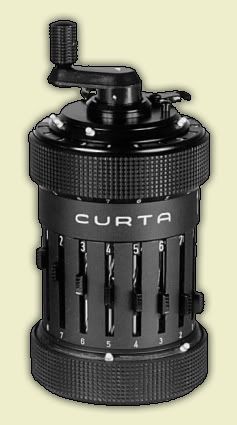[Even in death, Bane has the capability to fascinate. In this brief post written less than two weeks before his untimely passing, he provides a link to a blogpost about a remarkable object...]
Engineers, scientists, and businessmen often speak of “cranking out the numbers,” a familar idiomatic expression that originated with a unique device.
I speak of the Curta mechanical calculator, a handy little gadget that could do mathematical calculations to fifteen digits of precision. Addition, subtraction, division, and multiplication - all by turning a crank. Cranking out the answers...literally.

Vintage Curta mechanical calculator.
The Curta was invented by a Buchenwald concentration camp inmate in 1938 and manufactured in the tiny European principality of Liechtenstein up until 1970, when the appearance of new-fangled electronic calculators rendered it obsolete. The machines, which resemble the bastard children of pepper mills and hand grenades, can be found on eBay, where they command prices ranging up to several thousand dollars.
I first made the acquaintance of the Curta calculator back in the hallowed year of 1971.
Back then, the options available for doing mathematical calculations were, ahh, more limited than they are today. You could use a slide rule (AKA “slip-stick” in Engineering Nerdspeak) for most purposes, but you could only get answers with three or four significant digits at best. Fine for most engineering and technical problems, but not good enough if you had lab instructors who wanted, say, five or six decimal places.
Computers? Those were big things...big enough to fill entire buildings. Unwieldy (but usable) for a handful of simple calculations. All you had to do was write out a batch program in BASIC or FORTRAN, keypunch a deck of Hollerith cards, run ’em through the reader, and wait near the printer (a monstrosity the size of a Volkswagen) for your output.
You could do the math by hand, but long division and multiplication are slow, and they get awfully tiresome when you have huge numbers of individual calculations to do.
Hand-held calculators? That was, as of yet, the stuff of science fiction.
Enter the Curta.
I had a friend who owned one of these little beauties, and he was gracious enough to lend it to me (and teach me how to use it). It was like magic. You would set the counters, turn the crank atop the machine, it would click and whir like a living thing, and you would have your answers, with as many digits as you desired. Holy crap!
When the pocket-sized HP-35 electronic calculator appeared a year later - only $395! - it signaled the end of the mechanical calculator era. The HP-35 and its descendants could not only do the four basic math functions; they could perform logarithmic and trigonometric operations at the touch of a button...an engineer’s wet dream.
Comparing these new electronic marvels with the Curta is like comparing the modern digital camera to a vintage Leica, Hasselblad, or Crown Graphic. Functionally, the New Things run rings around the old...but they have no soul.
Try to imagine a world in which mechanical Difference Engines are the primary computational technology...the Curta as computa...and you have the world of The Difference Engine, a 1991 novel by William Gibson and Bruce Sterling. Steampunk! It would make for a very different sort of Internet...
But that’s a topic for another post, I figure.
Engineers, scientists, and businessmen often speak of “cranking out the numbers,” a familar idiomatic expression that originated with a unique device.
I speak of the Curta mechanical calculator, a handy little gadget that could do mathematical calculations to fifteen digits of precision. Addition, subtraction, division, and multiplication - all by turning a crank. Cranking out the answers...literally.

Vintage Curta mechanical calculator.
The Curta was invented by a Buchenwald concentration camp inmate in 1938 and manufactured in the tiny European principality of Liechtenstein up until 1970, when the appearance of new-fangled electronic calculators rendered it obsolete. The machines, which resemble the bastard children of pepper mills and hand grenades, can be found on eBay, where they command prices ranging up to several thousand dollars.
I first made the acquaintance of the Curta calculator back in the hallowed year of 1971.
Back then, the options available for doing mathematical calculations were, ahh, more limited than they are today. You could use a slide rule (AKA “slip-stick” in Engineering Nerdspeak) for most purposes, but you could only get answers with three or four significant digits at best. Fine for most engineering and technical problems, but not good enough if you had lab instructors who wanted, say, five or six decimal places.
Computers? Those were big things...big enough to fill entire buildings. Unwieldy (but usable) for a handful of simple calculations. All you had to do was write out a batch program in BASIC or FORTRAN, keypunch a deck of Hollerith cards, run ’em through the reader, and wait near the printer (a monstrosity the size of a Volkswagen) for your output.
You could do the math by hand, but long division and multiplication are slow, and they get awfully tiresome when you have huge numbers of individual calculations to do.
Hand-held calculators? That was, as of yet, the stuff of science fiction.
Enter the Curta.
I had a friend who owned one of these little beauties, and he was gracious enough to lend it to me (and teach me how to use it). It was like magic. You would set the counters, turn the crank atop the machine, it would click and whir like a living thing, and you would have your answers, with as many digits as you desired. Holy crap!
When the pocket-sized HP-35 electronic calculator appeared a year later - only $395! - it signaled the end of the mechanical calculator era. The HP-35 and its descendants could not only do the four basic math functions; they could perform logarithmic and trigonometric operations at the touch of a button...an engineer’s wet dream.
Comparing these new electronic marvels with the Curta is like comparing the modern digital camera to a vintage Leica, Hasselblad, or Crown Graphic. Functionally, the New Things run rings around the old...but they have no soul.
Try to imagine a world in which mechanical Difference Engines are the primary computational technology...the Curta as computa...and you have the world of The Difference Engine, a 1991 novel by William Gibson and Bruce Sterling. Steampunk! It would make for a very different sort of Internet...
But that’s a topic for another post, I figure.


















No comments:
Post a Comment